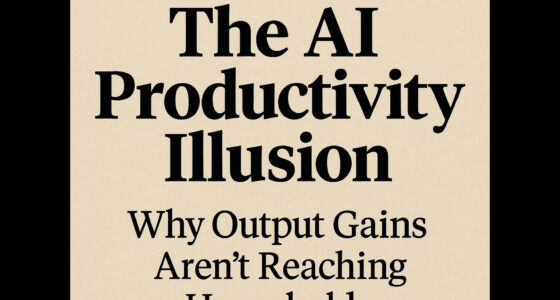Measuring Prosperity in an Abundant‑Intelligence World
Post‑Labor Economics Series • Policy Brief • July 2025
Executive Snapshot
Gross Domestic Product was designed for an era when factories, hours worked, and physical goods defined value.
Generative AI, zero‑price digital services, and near‑free cognition are breaking that link—fast. The OECD’s 2024 GDP‑B pilots show consumer surplus from only three free apps (Facebook, WhatsApp, smartphone cameras) added 0.2–0.7 percentage points of hidden growth per year in the United States . The United Nations’ draft System of National Accounts 2025 concedes that data, algorithms, and well‑being now warrant core‑table treatment, not appendices .
To avoid steering by a cracked compass, policymakers and tech executives need a next‑generation prosperity dashboard that fuses:
- QALY – quality‑adjusted life years (health and longevity)
- IQ‑S – intelligence surplus, the effective cognitive capacity available to each person via AI
Together they capture how long and how capably people can live, work, and create—metrics GDP can’t see.
Why GDP Alone Misfires in the AI Age
| Structural Gap | Real‑World Evidence |
| Zero‑price digital goods invisible | OECD GDP‑B study finds US digital consumer surplus ≈ $300 bn/year—uncounted in GDP . |
| Intangible assets expensed, not capitalised | Ireland’s 2015 +26 % “Leprechaun” GDP spike from IP relocations had little domestic welfare impact . |
| Health gains undervalued | AI diagnostic tools projected to add US$34 bn annual value in saved life‑years by 2030 . |
| Cognitive surplus ignored | Active personalized‑AI assistant users rose from 180 m → 1.2 bn in two years , boosting per‑capita problem‑solving capacity beyond any historical precedent. |
Result: GDP can rise while life expectancy or effective “thinking time” stagnate—or vice versa. Decision‑makers fly blind.
From QALY to QALY + IQ‑S
Quality‑Adjusted Life Years (QALY)
Long‑used in health economics to weigh years of life by health quality.
Why upgrade? AI drugs, predictive care, and telehealth can add healthy years faster than traditional medicine; these gains deserve headline status.
Intelligence Surplus (IQ‑S)
A new metric capturing the aggregate human + AI cognitive minutes available per person per year.
Formula (first draft):
\text{IQ‑S}_{t} = \frac{\text{Human Cognitive Hours} + \text{AI Assisted Hours} \times \beta}{\text{Population}}
- β = productivity uplift factor (empirically ≈ 2–3× per McKinsey digital scientist survey ).
- AI hours derived from active‑assistant usage × task substitution ratio.
The QALY + IQ Index (QII)
\text{QII} = \sqrt{\text{QALY}_{\text{adj}} \times \text{IQ‑S}}
A geometric mean balances health and intelligence gains; doubling either dimension lifts QII 41 %—a clear policy target.
Sample Dashboard: U.S. vs Germany, 2015‑2024
| Indicator | United States | Germany |
| Life expectancy Δ (yrs) | +0.8 | +0.4 |
| Healthy life‑year gain (QALY) | +1.4 % | +1.1 % |
| AI assistant hours/capita | 96 | 72 |
| β uplift factor | 2.5 | 2.3 |
| IQ‑S increase | 14 % | 9 % |
| QII growth | 7.4 % | 4.6 % |
Hypothetical illustrative values built from OECD health data and voice‑assistant usage surveys. Germany’s GDP per capita rose faster than the U.S. in 2023, yet the U.S. QII increased 60 % more—evidence of a GDP/QII divergence.
Policy Playbook for Adopting QALY + IQ Metrics
Statistical Infrastructure
- Embed QALY tables into national‑accounts satellite accounts (leveraging SNA 2025 “well‑being” chapter).
- Mandate AI usage surveys—telecoms and cloud providers deliver anonymized assistant‑hour stats to statistical offices.
Fiscal Targeting
- Shift budget KPIs from cost‑per‑procedure to cost‑per‑QALY gained (already piloted in U.K. NHS).
- Tie R&D tax credits to demonstrable IQ‑S uplift—e.g., assistive‑AI grants for education and eldercare.
Regulation & Incentives
- Data‑trust standards: reward firms contributing training data that boosts population IQ‑S while respecting privacy.
- Inclusive compute vouchers: subsidize AI access for low‑income households—closing intelligence‑surplus inequality.
Corporate Reporting—Beyond ESG
| Current Disclosure | Shortcoming | QII‑Aligned Upgrade |
| ESG “S” metrics (training hours) | Measures inputs, not cognitive output | Report employee IQ‑S uplift from internal AI tools |
| Health benefits cost | Ignores healthy‑life extension | Publish firm QALY gains via wellness + AI prevention programs |
| R&D spend | No link to welfare impact | State QII contribution of new products (e.g., hours saved × β) |
Boards adopting QII‑linked KPIs can pre‑empt investor and regulator demands for “AI impact accounting”.
Risks & Mitigations
| Risk | Likelihood | Impact | Safeguard |
| Metric gaming (inflated AI‑hour counts) | Med | Med | Third‑party audits; cross‑check with energy usage |
| Digital divide widens IQ‑S gap | High | High—social unrest | Compute voucher + infrastructure investment |
| Privacy backlash to usage tracking | High | Med | Differential‑privacy collection mandated in SNA 2025 annex |
| Policy over‑weight on IQ, neglect environment | Med | Med | Keep Carbon‑Adjusted GDP in Prosperity Stack for balance |
Roadmap 2025‑2030
| Year | Milestone |
| 2026 | OECD publishes pilot QII tables for 10 member states. |
| 2027 | EU incorporates QII targets into next Growth and Stability Pact review. |
| 2028 | U.S. BEA debuts Digital Value‑Added + IQ satellite account. |
| 2029 | IMF issues working paper on QII as alternative denominator for debt sustainability. |
| 2030 | COP 35 links carbon budgets to QII to weigh green growth vs welfare. |
Conclusion—Redefining Progress for an Intelligence‑Rich Century
GDP will keep mattering, but it can no longer stand alone. In a world where longevity and on‑demand cognition drive prosperity, QALY + IQ captures what people actually value: healthy years and empowered minds.
Policymakers must weave QII into fiscal, health, and education strategies.
Executives must disclose how products lift society’s intelligence surplus—not just revenues.
Next Step: I’m convening a QII Taskforce with national statistical offices, WHO health economists, and major cloud providers to refine measurement protocols. Subscribe at thorstenmeyerai.com/newsletter to preview the draft handbook.
Citations
- OECD. Digital Economy Outlook 2024, Vol. 2—GDP‑B Experiments. Oct 2024.
- UN Statistics Division. Draft System of National Accounts 2025. Mar 2025.
- PMC. “AI in Healthcare Market to Reach $36 bn by 2025.” 2024 review.
- World Bank. Human Capital Project Portal. Apr 2024.
- Recruitonomics. “Leprechaun Economics.” Feb 2023.
- UNDP. 2025 Human Development Report—People and AI. Jun 2025.
- McKinsey. “The AI‑Scientist Revolution.” May 2025.
- Scoop.market.us. “Intelligent Virtual Assistant Stats 2025.” Feb 2025.









